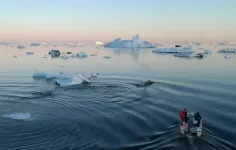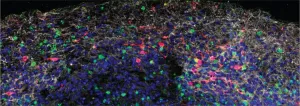A bucket of water can reveal climate change impacts on marine life in the Arctic
2021-01-12
(Press-News.org) Climate changes prompt many important questions. Not least how it affects animals and plants: Do they adapts, gradually migrate to different areas or become extinct? And what is the role played by human activities? This applies not least to Greenland and the rest of the Artic, which are expected to see the greatest effects of climate changes.
'We know surprisingly little about marine species and ecosystems in the Arctic, as it is often costly and difficult to do fieldwork and monitor the biodiversity in this area', says Associate Professor of marine mammals and instigator of the study Morten Tange Olsen from the GLOBE Institute at the Faculty of Health and Medical Sciences, University of Copenhagen.
To address these questions, researchers from the University of Copenhagen, Aarhus University and the Greenland Institute of Natural Resources collected water samples in West Greenland with the help of local hunters and fishermen. Their method is simple: Go out to sea in a small boat and collect water in bottles. The content, however, is far more complex. The bottles with seawater contain so-called environmental DNA, which can provide insight into how climate changes and human activities impact the biodiversity. The researchers have chosen to focus on the bowhead whale, which constitutes a key species in the Arctic ecosystem and therefore is a good indicator of changes in water temperatures and sea ice cover.
'The water samples contain enough DNA from bowhead whales to determine their presence, genetic diversity, the composition of the population and patterns of migration. You can actually monitor the marine biodiversity of the Arctic simply by going out in a small boat and collecting water in bottles, which is subsequently analysed in the DNA laboratory. This way, we are able to keep an eye on how humans and climate changes impact the bowhead whale and other marine life in the Arctic', says Morten Tange Olsen.
Footprint in a bottle
Together with local hunters and fishermen in Qeqertarsuaq (Godhavn), the researchers collected more than 100 one-litre water samples from Disko Bay in West Greenland in May 2017 and 2018. In May, the sea ice has just broken up and bowhead whales visit the area to forage. The samples were collected from small boats along transects and specifically in the 'footprint' of bowhead whales - the small ripples on the water surface created when the whales come up to breathe and dive again.
'There is a lot more bowhead whale DNA in such a footprint than in a random water sample collected at the same time in the same area. You can find bowhead whale DNA in a footprint at least 10 minutes after the whale dove', says Natasja Lykke Corfixen, who helped initiate the study as part of her master's thesis at the Faculty of Science at the University of Copenhagen and the Greenland Institute of Natural Resources.
By optimising the DNA methods in the laboratory, the researchers hope to be able to sequence the whale's entire genome based on water samples. 'So far we have managed to sequence mitochondrial genomes from the water samples, and we are currently testing various methods for capturing the whale's entire genome, as well as the genomes of the algae and crustaceans that form part of their food chain', says PhD Student at the GLOBE Institute Dóra Székely.
Health and genetics based on a water sample
The researchers hope that by optimising DNA extraction and sequencing protocols, and learning more about the connection between genes, behaviour and health, they will eventually be able to use the method to monitor the health status of the bowhead whale and many other animals.
'The field of Environmental DNA is seeing rapid development and is increasingly used for biodiversity monitoring in lakes, rivers, wetlands and, to some extent, the sea. We have shown that the method is also useful in the Arctic, and that it can be used to monitor not just the presence of a species, but also its diversity and patterns of movement. By further developing this simple method we are able to significantly increase our knowledge of marine biodiversity, and hopefully the impact of both climate changes and human activities', says Morten Tange Olsen.
INFORMATION:
[Attachments] See images for this press release:

ELSE PRESS RELEASES FROM THIS DATE:
2021-01-12
Researchers from Skoltech and their colleagues have optimized data analysis for a common method of studying the 3D structure of DNA in single cells of a Drosophila fly. The new approach allows the scientists to peek with greater confidence into individual cells to study the unique ways DNA is packaged there and get closer to understanding this crucial process's underlying mechanisms. The paper was published in the journal Nature Communications.
The reason a roughly two-meter-long strand of DNA fits into the tiny nucleus of a human cell is that chromatin, a complex of DNA and proteins, packages it ...
2021-01-12
A study of students at seven public universities across the United States has identified risk factors that may place students at higher risk for negative psychological impacts related to the COVID-19 pandemic. Factors associated with greater risk of negative impacts include the amount of time students spend on screens each day, their gender, age and other characteristics.
Research has shown many college students faced significant mental health challenges going into the COVID-19 pandemic, and experts say the pandemic has added new stressors. The findings, published in the journal PLOS ONE, could help experts tailor services ...
2021-01-12
Announcing a new publication for Marine Life Science & Technology journal. In this research article the authors Hungchia Huang, Jinpeng Yang, Shixiang Huang, Bowei Gu, Ying Wang, Lei Wang and Nianzhi Jiao from Xiamen University, Xiamen, China and Sun Yat-Sen University, Guangzhou, China consider the spatial distribution of planktonic ciliates in the western Pacific Ocea: along a transect from Shenzhen (China) to Pohnpei (Micronesia).
Planktonic ciliates have been recognized as major consumers of nano- and picoplankton in pelagic ecosystems, playing pivotal roles in the transfer ...
2021-01-12
COLUMBIA, Mo. - As a former school nurse in the Columbia Public Schools, Gretchen Carlisle would often interact with students with disabilities who took various medications or had seizures throughout the day. At some schools, the special education teacher would bring in dogs, guinea pigs and fish as a reward for good behavior, and Carlisle noticed what a calming presence the pets seemed to be for the students with disabilities.
Now a research scientist at the MU Research Center for Human-Animal Interaction (ReCHAI) in the MU College of Veterinary Medicine, Carlisle studies the benefits that companion animals can have on families. While there is plenty of ...
2021-01-12
New Orleans, LA - Catherine O'Neal, MD, Assistant Professor of Clinical Medicine at LSU Health New Orleans School of Medicine's branch campus in Baton Rouge, is a co-author of a paper reporting that shortening the length of quarantine due to COVID exposure when supported by mid-quarantine testing may increase compliance among college athletes without increasing risk. The findings are published in the Centers for Disease Control and Prevention's January 8, 2021 Morbidity and Mortality Weekly Report (MMWR), available here.
CDC partnered with representatives of the NCAA conferences to analyze retrospective data collected by participating colleges and universities. De-identified data from a total of 620 ...
2021-01-12
Gut microbes passed from female mice to their offspring, or shared between mice that live together, may influence the animals' bone mass, says a new study published today in eLife.
The findings suggest that treatments which alter the gut microbiome could help improve bone structure or treat conditions that weaken bones, such as osteoporosis.
"Genetics account for most of the variability in human bone density, but non-genetic factors such as gut microbes may also play a role," says lead author Abdul Malik Tyagi, Assistant Staff Scientist at the Division of Endocrinology, Metabolism, and Lipids at Emory Microbiome Research Center, Emory University, Georgia, US. "We wanted to investigate the influence of the microbiome on skeletal growth and bone mass development."
To ...
2021-01-12
Using both mouse and human brain tissue, researchers at Yale School of Medicine have discovered that SARS-CoV-2 can directly infect the central nervous system and have begun to unravel some of the virus's effects on brain cells. The study, published today in the Journal of Experimental Medicine (JEM), may help researchers develop treatments for the various neurological symptoms associated with COVID-19.
Though COVID-19 is considered to primarily be a respiratory disease, SARS-CoV-2 can affect many other organs in the body, including, in some patients, the central nervous system, where infection is associated with ...
2021-01-12
The first step in treating cancer is understanding how it starts, grows and spreads throughout the body. A relatively new cancer research approach is the study of metabolites, the products of different steps in cancer cell metabolism, and how those substances interact.
To date, research like this has focused mostly on cancerous tissues; however, normal tissues that surround tumors, known as the extratumoral microenvironment (EM), may have conditions favorable for tumor formation and should also be studied.
In a new study published in the journal PLOS ONE, researchers investigated the metabolites involved in the growth and spread of melanoma, a rare but deadly ...
2021-01-12
Almost 18,000 Americans experience traumatic spinal cord injuries every year. Many of these people are unable to use their hands and arms and can't do everyday tasks such as eating, grooming or drinking water without help.
Using physical therapy combined with a noninvasive method of stimulating nerve cells in the spinal cord, University of Washington researchers helped six Seattle area participants regain some hand and arm mobility. That increased mobility lasted at least three to six months after treatment had ended. The research team published these findings Jan. 5 in the journal ...
2021-01-12
A recent study finds that, in the wake of a mass shooting, National Rifle Association (NRA) employees, donors and volunteers had extremely mixed emotions about the organization - reporting higher levels of both positive and negative feelings about the NRA, as compared to people with no NRA affiliation.
"We wanted to see what effect 'in-group' affiliation and political identity had on how people responded to the NRA's actions after a mass shooting," says Yang Cheng, co-author of the study and an assistant professor of communication at North Carolina State University. "The political findings were predictable - Republicans thought more favorably of the NRA than Democrats did. But the in-group affiliation was a lot more complex than ...
LAST 30 PRESS RELEASES:
[Press-News.org] A bucket of water can reveal climate change impacts on marine life in the Arctic



